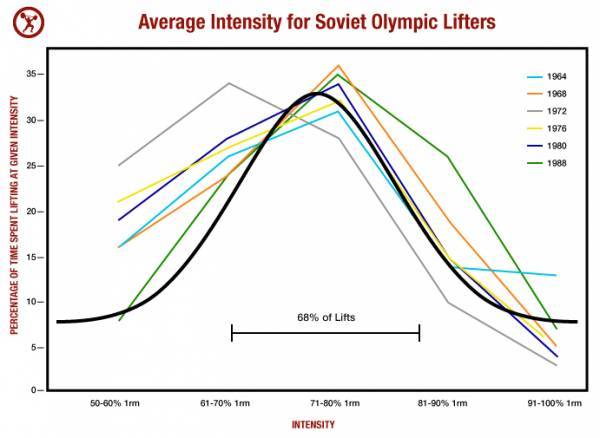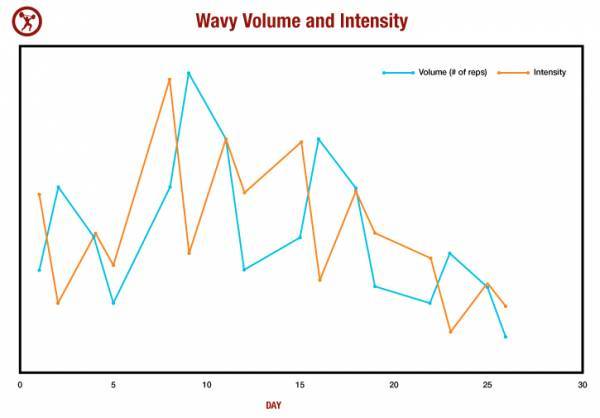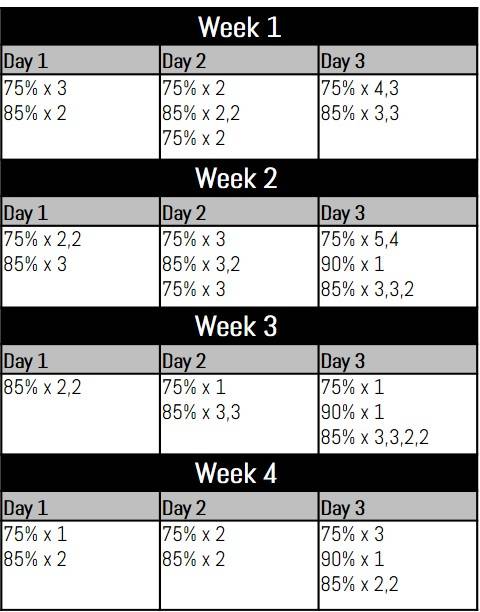Last week I covered a simple endurance program that creates an anabolic environment to prime you for strength training. This week we’ll cover the most powerful strength program I have used. Russel Dunning and his athletes used this program with great success in attempting the StrongFirst Level II half-bodyweight kettlebell press. Many athletes fail this strength test, but all of his athletes on this program passed easily.
This program will help you get strong and stay that way for years.
The half-bodyweight kettlebell press takes serious strength. This program can help you get there. [Photo courtesy Craig Marker]
The Soviet Discovery of Training Waves
Many Western periodization programs have an inverse relationship between training intensity and volume. These programs are linear in that you add weight in successive weeks and reduce the total number of lifts. Research from the Soviet weightlifting programs of the 1970s and 80s reveals that waving the volume and intensity might be the key to long-term strength gains and durability.
Again, I need to rely on my mentor Pavel Tsatsouline for his insight into the Soviet training methods. The Soviets were methodical about keeping records of every training session, but most of this research is still published in Russian. The leading Soviet scientists looked at the data and found interesting patterns. From those patterns, they created the training principles that produced some of the most successful and durable athletes in world history.
More Soviet Training Secrets:
Why You Should Warm Up Less (Like the Russians Do)
Don’t Train Heavy All the Time
First, the Soviet Olympic weightlifting team did not often attempt 1-rep maxes (1RM) in their training. Most of their training was done with 65% to 85% of their 1RM. This method is contrasted with the Bulgarian style training systems, which rely on much heavier weights in training.
The Bulgarians were also successful in Olympic lifting; however, their athletes were not known for their long-term durability. Many of the Soviet lifters broke Olympic records long into their thirties. Leonid Taranenko won his first Olympic medal in 1980 and his last in 1992 at the age of 36. Taranenko’s combined total in 1988 for the snatch and clean and jerk was 475kg (1,047lb), and remains the heaviest ever lifted in a competition.

A close examination of Soviet training records reveals that their record-shattering athletes rarely approached their 1-rep max in training.
Decouple Volume and Intensity
If we define volume as the total number of lifts and intensity as a percentage of 1RM, we often see a pattern in Western programs. Most programs start off with more reps at lower weights and work toward weeks with few lifts at heavier weights. These programs are called linear because you add weight each week. A simple example is Wendler’s 5-3-1 program. In the first week, the person lifts 5 reps at around 75% of his or her 1RM. By the third week, the person is lifting one rep at 85-90% of his or her 1RM.
The Soviets decoupled volume and intensity. One week might be high volume and high intensity and the next week would be low intensity and medium volume. Waving the volume and intensity allows for more natural recovery and greater strength gains.

Varying volume and intensity independently can lead to better gains in strength, and increased longevity for the athlete.
The Wavy Strength Periodization Program
This program can be done on days when you are not completing endurance work. There will be some days that seem too simple (e.g., week 3, day 1) and some days that are not so easy (e.g., week 2, day 3). Stick to the program. Do not add weight because you feel better that day.
I would suggest sticking to one exercise for the month. If you are also following the endurance program described last week, the kettlebell swings will maintain your explosive leg power. In combination with the endurance program, this program would work well for a press.
The chart below provides values and reps for each day. For example, if your kettlebell press 1RM is 100lb, then you only need three weights: 75lb, 85lb, and 90lb. Please don’t worry if you don’t have the exact weights. A 32kg (72lb), 36kg (80lb), and 40kg (88lb) could easily be substituted. Start with lighter weight to warm up. You shouldn’t start right away at 75% of your 1RM. Rest periods should be greater than ninety seconds as you want to have as much power as possible on each set. You might take up to eight minutes before trying your 90% weights.
To read the chart, take the weight that is listed and do the number of reps. For example, on day 2 of week 1, you would do:
- A set of 2 with 75%
- A set of 2 with 85%
- A set of 2 with 85%
- A final set of 2 with 75%

Feeling stronger than the prescribed weight for the day? Great. Stick to the program anyway.
At the end of the month, start the program over. This program is well-suited to beginners and advanced athletes. There are many fine nuances to these programs, but they are a bit much to discuss in this article. For example, you could create even wavier volume and intensity programs.
Get Stronger Now, And In the Long Term
In my experience, everyone who has used this training program has reported a great deal of success. Fabio Zonin, Russ Dunning, and Tony Gracia have trained high-level athletes using these methods. Pavel based the keys of his program on the Soviet training systems. Soviet athletes were not only known for breaking all the Olympic records, but also for maintaining durability.
I have heard of many beginning athletes starting a linear style program and staying on it because of the initial success. Usually they get injured, which causes them to take a break before starting another linear program. Ultimately, the linear program becomes a wavy program as injuries stop their progress.
The above program builds in the ups and downs to keep you durable. The key is to wave the volume and the intensity without coupling them together. It might mean that some weeks are low intensity and medium volume (easy) and others are high intensity and high volume. In my work with the program, there have been 15-minute sessions and 2-hour long sessions. Stick to the program, and you will notice great strength gains and long-term durability.






